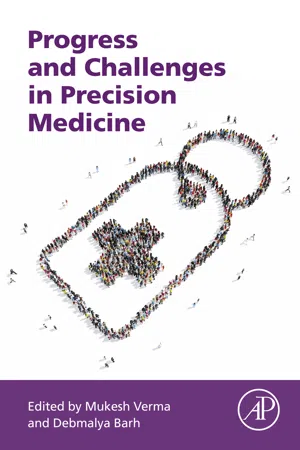
- 344 pages
- English
- ePUB (mobile friendly)
- Available on iOS & Android
Progress and Challenges in Precision Medicine
About This Book
Progress and Challenges in Precision Medicine presents an insightful overview to the myriad factors of personalized and precision medicine. The availability of the human genome, large amounts of data on individual genetic variations, environmental interactions, influence of lifestyle, and cutting-edge tools and technologies for big-data analysis have led to the age of personalized and precision medicine.
Bringing together a global range of experts on precision medicine, this book collects previously scattered information into one concise volume which covers the most important developments so far in precision medicine and also suggests the most likely avenues for future development.
The book includes clinical information, informatics, public policy implications, and information on case studies. It is a useful reference and background work for students, researchers, and clinicians working in the biomedical and medical fields, as well as policymakers in the health sciences.
- Provides an overview of the growing field of precision medicine
- Contains chapters from geographically diverse experts in their field
- Explores important aspects of precision medicine, including applications, ethics, and development
Frequently asked questions
Information
Introduction
Every Individual Is Different and Precision Medicine Offers Options for Disease Control and Treatment
Abstract
Keywords
1. What Is Precision Medicine? Personalized Medicine Versus Precision Medicine (C. HIzel, P. Hamet, and J. Tremblay)
Table of contents
- Cover image
- Title page
- Table of Contents
- Copyright
- List of Contributors
- Biography
- Dedication
- Preface
- Chapter 1. Introduction: Every Individual Is Different and Precision Medicine Offers Options for Disease Control and Treatment
- Chapter 2. Clinical Next-Generation Sequencing: Enabling Precision Medicine
- Chapter 3. Phenotyping in Precision Medicine
- Chapter 4. Cancer Genetic Screening and Ethical Considerations for Precision Medicine
- Chapter 5. Precision Medicine in Primary Health Care
- Chapter 6. Population Approach to Precision Medicine
- Chapter 7. Regulation of Genomic Testing in the Era of Precision Medicine
- Chapter 8. Image-Based Modeling and Precision Medicine
- Chapter 9. Sharing Outside the Sandbox? The Child’s Right to an Open Data Sharing Future in Genomics and Personalized Medicine
- Chapter 10. Lessons Learned From Cohort Studies, and Hospital-Based Studies and Their Implications in Precision Medicine
- Chapter 11. Clinical Trials in Precision Medicine
- Chapter 12. Time to Educate Physicians and Hospital Staff in Electronic Medical Records for Precision Medicine
- Chapter 13. Computational Approaches in Precision Medicine
- Chapter 14. Handling Big Data in Precision Medicine
- Chapter 15. Trends in Precision Medicine
- Chapter 16. Personalized Medicine: Interdisciplinary Perspective, World Tidal Wave, and Potential Growth for the Emerging Countries
- Index